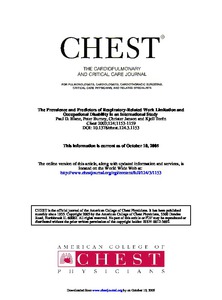The prevalence and predictors of respiratory-related work limitation and occupational disability in an international study

Blanc, Paul D. ; Burney, Peter ; Janson, Christer ; Torén, Kjell
2003
124
3
1153-1159
asthma ; chemicals ; employability ; epidemiologic study ; exposure ; frequency rates ; lung diseases ; occupational risks
Occupational diseases
https://doi.org/10.1016/S0012-3692(15)37681-9
English
Bibliogr.
"Work disability due to lung disease is common and costly. This problem stems from the prevalence of lung disease, especially asthma, among adults of working age. Even upper respiratory tract complaints that are generally considered to be nondisabling, such as allergic rhinitis, may be associated with prominent decrements in work productivity.
The origins of workplace disability are multifactorial and reflect an interaction between a person with a health condition causing an impairment and the environment, which may induce or aggravate symptoms and limit functional ability. Occupational conditions comprise a critical component of this environment. Exposure to irritants, dusts, or other adverse conditions that are known or suspected to cause or aggravate respiratory disease might be expected to promote disability as well. In occupational terms, the most severe manifestation of disability is the complete cessation of employment. Short of this, there are a number of other important measures of occupational disability, including lost work days, change in employment, limitation in duties, or reduction in the number of work hours due to ill health.
We used data from an international study of lung disease among adults of working age, the European Community Respiratory Health Survey (ECRHS), to analyze the impact of workplace exposures on respiratory symptoms at work and on reported changes in job due to breathing difficulty, which we used as a measure of occupational disability. We were particularly interested in this question because of an earlier analysis of ECRHS data from Sweden that had indicated such occupational disability was common and was related to working conditions. We hypothesized that this association would be consistent internationally over a range of potential exposures. "
Digital
The ETUI is co-funded by the European Union. Views and opinions expressed are however those of the author(s) only and do not necessarily reflect those of the European Union or the ETUI.